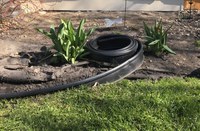Dakota Gardener: Unexplored Vegetable Garden Spaces
(Click an image below to view a high-resolution image that can be downloaded)
By Carrie Knutson, NDSU Extension Agent, Grand Forks County
You always seem to have projects when you own a home.
As a gardener, I tend to add more to the outside to-do list than the inside list. I have been working on re-doing the rock and fabric landscaping around my house.
The work is slow, one shovelful at a time, but this spring I am reaching my goal of finishing the backyard. I plan on removing the rock entirely from the last section for a flower bed.
The original plan was to create a pollinator garden that would complement the other pollinator-friendly plants in my yard. I still have that goal, but now I want to include some sun- and heat-loving vegetables such as tomatoes, peppers and herbs in that space.
In other beds, I want to explore and try growing new vegetables such as kohlrabi and Swiss chard this year. It’s exciting!
If you are looking to increase your vegetable garden space this year and are short on time, consider combining ornamentals and edibles in your landscape plantings. The space you want to plant in should receive enough sunlight for the vegetables you want to grow.
Most vegetables need eight or more hours of sunlight a day for good production. Leafy greens such as lettuce, spinach and kale will grow well with six to eight hours of sunlight.
Also make sure you are able to get water to the vegetables easily when needed. Don’t crowd the plants together, and make sure each vegetable or flower has the space it needs to grow.
Vegetables can serve as a design element in a landscape if you look at them in the right light. The large, thick leaves of zucchini can contrast nicely with the dark blue, fountainlike foliage of broccoli. Throw in some cosmos, zinnias or marigolds in your favorite color and you have an eye-catching vegetable garden.
Vegetables can be grown easily in containers to provide more growing space. However, you have a few things to keep in mind.
The container size should match the root depth and plant size. For example, lettuce and onions can be grown in small, shallow containers, while tomatoes will need large, deep (5 to 10 gallons) containers. When in doubt, use a bigger container than you think the plant needs.
You can find containers of different types (fabric, plastic, clay or metal) and items you can repurpose as containers. I’ve seen creative gardeners use old wheelbarrows, teapots and even boots as containers. Use your imagination.
Regardless of the type, all containers should have drainage holes in the bottom. Containers will need daily watering, especially when the weather is hot, and weekly applications of a water-soluble fertilizer.
If you are not ready to devote all your container space to vegetables, incorporate a few of your favorite vegetables into your containers. The plants you are going to use together should have the same growing requirements for light and moisture and have complementary space needs. For example, plant a container with a tall pepper, a trailing flower and a shorter leafy green.
One final note: Making sure members of your family know what is safe to eat and what is not when combining plantings is a good idea. Happy planting!
For more information, contact your local NDSU Extension agent. Find the Extension office for your county at https://www.ag.ndsu.edu/extension/directory/counties.
NDSU Agriculture Communication - May 19, 2020
| Source: | Carrie Knutson, 701-780-8229, carrie.knutson@ndsu.edu |
|---|---|
| Editor: | Ellen Crawford, 701-231-5391, ellen.crawford@ndsu.edu |




